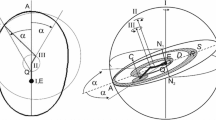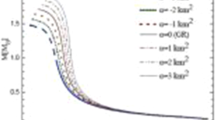Abstract
This paper continues the series of papers [1–5] and generalizes the previous results to a proto-ring of magnetized plasma whose density decreases in the radial direction. The problem of quantization of the sector and orbital velocities, and of the radii and periods of revolution of elite plasma rings is considered. A new concept of super-elite rings is introduced. Their isomorphism with the orbits of the planets and planetary satellites in the Solar System is proved. This isomorphism also extends to the orbits of electrons in the Bohr’s model of the hydrogen atom.
Similar content being viewed by others
References
Rabinovich, B.I., Magnetohydrodynamics of a Rotating Eddy Rings of Magnetized Plasma, Dokl. Akad. Nauk, 1996, vol. 351, no. 3, pp. 335–338.
Rabinovich, B.I., A Plasma Ring Rotating in Gravitational and Magnetic Fields: Problems of Stability, Dokl. Akad. Nauk, 1999, vol. 367, no. 3, pp. 345–348.
Rabinovich, B.I., Dynamics of Plasma Ring Rotating in the Magnetic Field of a Central Body: Magneto-Gravitational Waves, Kosm. Issled., 2006, vol. 44, no. 1, pp. 43–51.
Rabinovich, B.I., On Dynamics of a Plasma Ring Rotating in the Magnetic Field of a Central Body: Magneto-Gyroscopic Waves. Problems of Stability and Quantization, Kosm. Issled., 2006, vol. 44, no. 2, pp. 146–161.
Rabinovich, B.I., Planetary Rings as Relics of Plasma Pre-Rings, Kosm. Issled., 2007, vol. 45, no. 1, pp. 44–58.
The Planetary Report, 2005, vol. 25, no. 1, p. 21.
Molchanov, A.M., Resonances in Multi-Frequency Oscillations, Dokl. Akad. Nauk SSSR, 1966, vol. 168, no. 2, pp. 284–287.
Molchanov, A.M., On Resonance Structure of the Solar System, in Sovremennye problemy nebesnoi mekhaniki i astrodinamiki (Contemporary Problems of Celestial Mechanics and Astrodynamics), Moscow: Nauka, 1973.
Beletsky, V.V., Ocherki o dvizhenii kosmicheskikh tel (Essays on Motion of Celestial Bodies), Moscow: Nauka, 1977.
Blekhman, I.I., Sinkhronizatsiya v prirode i v tekhnike (Synchronization in Nature and in Technology), Moscow: Nauka, 1981.
Roy, A.E. and Ovenden, M.W., On the Occurrence of Commensurable Mean Motions in the Solar System. The Minor Theorem, Mon. Not. RAS, 1955, vol. 115.
Demin, V.G., Sud’ba Solnechnoi sistemy (The Destiny of the Solar System), Moscow: Nauka, 1969.
Safronov, V.S. and Vityazev, A.V., Origination of the Solar System, in Itogi Nauki Tekh.: Ser. Astronomiya, vol. 24, Moscow: VINITI, 1983.
Marov, M.Ya., Planety Solnechnoi sistemy (Planets of the Solar System), Moscow: Nauka, 1986.
Khentov, A.A., Synchronization of Satellites, in Dinamika sistem. Mezhvuz. sb. (Dynamics of Systems: An Interuniversity Collection of Papers), issue 4, Gorky, 1974.
Nazarenko, A.I., Evolyutsiya i ustoichivost’ sputnikovykh sistem (Evolution and Stability of Satellite Systems), Moscow: Mashinostroenie, 1981.
Goldreich, P., Explanation to Frequently Observed Commensurability of Mean Motions in the Solar System, in Prilivy i rezonansy v Solnechnoi sisteme (Tides and Resonances in the Solar System), Zharkov, V.N., Ed., Moscow: Mir, 1975.
Grebennikov, E.A. and Ryabov, Yu.A., Rezonansy i malye znamenateli v nebesnoi mekhanike (Resonances and Small Denominators in Celestial Mechanics), Moscow: Nauka, 1978.
Fridman, A.M. and Polyachenko, V.L., Ravnovesie i ustoichivost’ gravitiruyushchikh sistem (Equilibrium and Stability of Gravitating Systems), Moscow, Nauka, 1976. Translated under the title Physics of Gravitating Systems, vols. 1 and 2, New York: Springer, 1984.
Gor’kavy, N.N. and Fridman, A.M., On Resonance Nature of the Rings of Uranus as Determined by Its Undiscovered Satellites, Pis’ma Astron. Zh., 1985, vol. 11, no. 9, pp. 717–720.
Gor’kavy, N.N. and Fridman, A.M., Resonance Nature of the Rings of Uranus and Prediction of Its New Satellites, Usp. Fiz. Nauk, 1986, vol. 150, no. 4, pp. 628–632.
Fridman, A.M. and Gor’kavy, The Physics of Planetary Rings, in Dynamics of the Solar System, Sidlichovsky, M., Ed., Prague: Publ. Astron. Inst. Czechosl. Acad. Sci., 1987, p. 175.
Gor’kavy, N.N. and Fridman, A.M., Fizika planetnykh kolets. Nebesnaya mekhanika sploshnoi sredy (Physics of Planetary Rings: Celestial Mechanics of Continua), Moscow: Nauka. Fizmatgiz, 1997.
Hagihara, Yu., Stability of the Solar System, in Planety i sputniki (Planets and Satellites), Moscow: Inostr. Lit., 1963.
Blekhman, I.I., Problem of Stability of Periodic Solutions to Quasilinear Nonautonomous Systems with Many Degrees of Freedom, Dokl. Akad. Nauk SSSR, 1955, vol. 104, no. 6.
Blekhman, I.I., Stability of Periodic Solutions to Quasilinear Nonautonomous Systems with Many Degrees of Freedom, Dokl. Akad. Nauk SSSR, 1957, vol. 112, no. 2.
Blekhman, I.I. and Lavrov, B.P., One Integral Indicator of the Stability of Motion, Prikl. Mat. Mekh., 1960, vol. 24, no. 5.
Blekhman, I.I., Substantiation of the Integral Indicator of Motion Stability in the Problem of Self-Synchronization of Vibrators, Prikl. Mat. Mekh., 1960, vol. 24, no. 6.
Blekhman, I.I., Integral Criterion of Stability for Periodic Motions of Some Nonlinear Systems and Its Applications, in Trudy Mezhdunar. Simpoziuma po nelineinym kolebaniyam. T. 2 (Proc. Intern. Symposium on Nonlinear Oscillations, vol. 2), Kiev: Izd. AN USSR, 1963.
Ovenden, M.W., Feagin, T., and Graff, O., On the Principle of Least Interaction Action and the Laplacian Satellites of Jupiter and Uranus, Celestial Mechanics, 1973, vol. 8, no. 3.
Beletsky, V.V. and Shlikhtin, A.I., Extreme Properties of Resonance Motions, Dokl. Akad. Nauk SSSR, 1976, vol. 231, no. 4.
Beletsky, V.V., Extreme Properties of Resonance Motions, in Tezisy dokl. 3-i Vsesoyuznoi Chetaevskoi konf. (The 3rd Chetaev All-Union Conference, Book of Abstracts), Irkutsk: Izd. SO AN SSSR, 1977.
Blekhman, I.I., Stability of Orbital Systems, in Tezisy dokl. 3-i Vsesoyuznoi Chetaevskoi konf. (The 3rd Chetaev All-Union Conference, Book of Abstracts), Irkutsk: SO AN SSSR, 1977.
Kudielka, V., The Dynamical Behavior of Our Planet System, Kluwer Academic, 1977.
Chechelnitsky, A.M., Ekstremal’nost’, ustoichivost’, rezonansnost’v astrodinamike i kosmonavtike (Extremity, Stability, and Resonances in Aerodynamics and Astronautics), Moscow: Mashinostroenie, 1980.
Chechelnitsky, A.M., Wave Structure, Quantization, and Mega-Spectroscopy of the Solar System, in Dinamika kosmicheskikh apparatov i issledovaniya kosmicheskogo prostranstva (Dynamics of Spacecraft and Exploration of Space), Moscow: Mashinostroenie, 1986.
Chechelnitsky, A.M., System of Uranus. The Solar System and Wave Astrodynamics: Theoretical Predictions and Observations of the Voyager 2 Spacecraft, Dokl. Akad. Nauk SSSR, 1988, vol. 303, no. 5, pp. 1082–1088.
Chechelnitsky, A.M., Neptune—Unexpected and Predicted. Prognosis of Theory and Voyager 2 Observations, Report (IAF-92-0009) to the World Space Congress, Washington, DC: AIAA Prepr., 1992.
Chechelnitsky, A.M., The Concept of Wave Astrodynamics and Its Consequences, in Izbr. trudy vtoroi sibirskoi konferentsii po matematicheskim problemam fiziki prostranstva-vremeni slozhnykh sistem (FPV-98) (Selected Papers of the 2nd Siberian Conf. on Mathematical Problems of Physics of Space and Time for Complex Systems (FPV-98), Novosibirsk, June 19–21, 1998.
Chechelnitsky, A.M., Horizons and New Possibilities for Astronautical System’s Megaspectroscopy, Adv. Space Res., 2002, vol. 29, no. 12, pp. 1917–1922.
Chetaev, N.G., Stable Trajectories in Dynamics, in Ustoichivost’ dvizheniya. Raboty po analiticheskoi mekhanike (Stability of Motion: Papers on Analytical Mechanics), Moscow: Akad. Nauk SSSR, 1962, p. 255.
Gareev, F.A., Geometrical Quantization of Micro-and Macro-Systems: Planetary-Wave Structure of Hadronic Resonances, in Soobshcheniya Ob’edinennogo Instituta Yadernykh Issledovanii (Communications of Joint Institute of Nuclear Research), Dubna, 1996.
Allen, C.W., Astrophysical Quantities, 3rd ed., London: The Athlone Press, 1973.
Nieto, M.M., The Titius-Bode Law of Planetary Distances: Its History and Theory, Oxford: Pergamon, 1972. Translated under the title Zakon Titsiusa-Bode. Istoriya i teoriya, Moscow: Mir, 1976.
Ural’skaya, V.S., Dynamics of Satellites of Planets in the Solar System, Astron. Vestn., 2003, vol. 37, no. 5, pp. 371–399.
Ural’skaya, V.S., New Data on the Satellite System of Saturn, Zemlya Vselennaya, 2005, no. 5, pp. 35–38.
Cherepashchuk, A.M. and Chernin, A.D., Vselennaya, zhizn’, chernye dyry (Universe, Life, and Black Holes), Fryazino: Vek 2, 2003.
Hills, I.G., Dynamic Relaxation of Planetary Systems and Bode’s Law, Nature, 1970, vol. 225.
Safronov, V.S., Evolyutsiya doplanetnogo oblaka i obrazovanie Zemli i planet (Evolution of Protoplanetary Cloud and Formation of the Earth and Planets), Moscow: Nauka, 1969.
Kozlov, N.N. and Eneev, T.M., Numerical Simulation of the Process of Formation of Planets from the Protoplanetary Cloud, Preprint of Keldysh Inst. of Applied Math., Russ. Acad. Sci., Moscow, 1974, no. 134.
Kozlov, N.N. and Eneev, T.M., Dynamics of the Process of Accumulation for Planets of the Earth’s Group. Formation of the Process of Inverse Rotation of Venus, Preprint of Keldysh Inst. of Applied Math., Russ. Acad. Sci., Moscow, 1978, no. 135.
McLachlan, N.W., Theory and Application of Mathieu Functions, Oxford: Clarendon Press, 1947. Translated under the title Teoriya i prilozhenie funktsii Mat’e, Moscow: Nauka, 1981.
Alfven, H., Cosmic Plasma, Dordrect: Reidel, 1981. Translated under the title Kosmicheskaya plazma, Moscow: Mir, 1975.
Tcherny, V.V. and Pospelov, A.Yu., About Hypothesis of the Superconducting Origin of the Saturn’s Rings, Astrophys. Space Science, 2007, vol. 307, no. 4, pp. 347–356.
Duc de La Rochefoucauld, Francois, Memuary. Maksimy (Memoirs, Maxims), Moscow: OOO Izd. AST, 2003.
Feynman, R.P., Leighton, R., and Sands, M., The Feynman Lectures on Physics, Reading, MA: Addison Wesley, 1964. Translated under the title Feinmanovskiye lektsii po fizike, Moscow: Mir, 1965, vol. 1.
Author information
Authors and Affiliations
Corresponding author
Additional information
Original Russian Text © B.I. Rabinovich, 2007, published in Kosmicheskie Issledovaniya, 2007, Vol. 45, No. 5, pp. 420–434.
Rights and permissions
About this article
Cite this article
Rabinovich, B.I. Super-elite plasma rings and the orbits of planets and satellites isomorphic to the orbits of electrons in the Bohr’s model of the hydrogen atom. Cosmic Res 45, 393–407 (2007). https://doi.org/10.1134/S0010952507050048
Received:
Issue Date:
DOI: https://doi.org/10.1134/S0010952507050048




